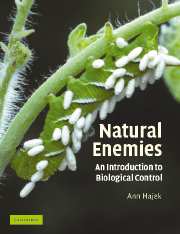Book contents
- Frontmatter
- Contents
- Preface
- Acknowledgments
- Introduction
- PART I Strategies for using natural enemies
- PART II Biological control of invertebrate and vertebrate pests
- PART III Biological control of weeds
- PART IV Biological control of plant pathogens and plant parasitic nematodes
- PART V Biological control: concerns, changes, and challenges
- Glossary
- References
- Index
PART IV - Biological control of plant pathogens and plant parasitic nematodes
Published online by Cambridge University Press: 05 June 2012
- Frontmatter
- Contents
- Preface
- Acknowledgments
- Introduction
- PART I Strategies for using natural enemies
- PART II Biological control of invertebrate and vertebrate pests
- PART III Biological control of weeds
- PART IV Biological control of plant pathogens and plant parasitic nematodes
- PART V Biological control: concerns, changes, and challenges
- Glossary
- References
- Index
Summary
Biological control of plant pathogens and plant parasitic nematodes occurs at a different size scale than control of pestiferous invertebrates, vertebrates, or plants. Most plant pathogens are microscopic organisms, also called microorganisms or microbes, and they predominantly belong to the fungi, bacteria, and viruses, with some flagellate protists, among others. Plant pathogenic nematodes are generally covered within the context of plant pathogens, because the majority are microscopic. However, plant parasitic nematodes are more complex organisms than microbial plant pathogens, being eukaryotic and multicellular with organ systems.
Plant pathogens cause losses in agriculture, horticulture, and forestry. It was estimated in 1997 that in the USA alone, crop losses valued at $9.1 billion due to diseases occur each year (Agrios, 1997). Losses to disease in developing countries are much greater and one could argue that these countries would be more sensitive to losses in food crops than the USA. Crop losses by plant parasitic nematodes were estimated in 1987 at US$77 billion worldwide yearly on 21 crops (Sasser & Freckman, 1987).
Numerous plant pathogens have developed methods for rapidly infecting and dispersing, sometimes causing epidemics leading to serious levels of damage if not complete loss of a crop. In 1845 and 1846, an epidemic of the chromist Phytophthora infestans obliterated the potato crop, the staple food of the Irish populace, and caused widespread famine. This well-known example demonstrates the impact a plant disease epidemic can potentially have.
- Type
- Chapter
- Information
- Natural EnemiesAn Introduction to Biological Control, pp. 259 - 260Publisher: Cambridge University PressPrint publication year: 2004



